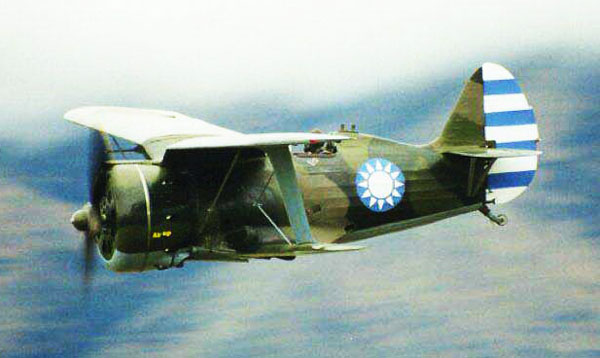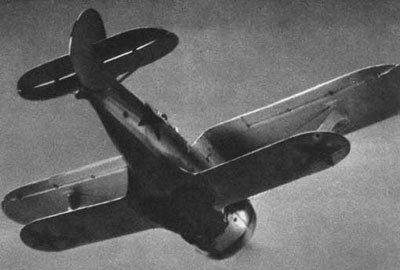Polikarpov I - 153

Polikarpov I-153 Last Biplane Used In World War II
 Biplane fighters were largely rendered obsolete by the new 1930s generation of monoplane combat aircraft but in a few notable instances they soldiered on and made their mark when nothing more modern was available. The I-153 was an outstanding example of this expediency foisted on the Russians after the German invasion of june 22, 1941 and it helped to hold the line against the enemy in the early days of the war in the East.
Biplane fighters were largely rendered obsolete by the new 1930s generation of monoplane combat aircraft but in a few notable instances they soldiered on and made their mark when nothing more modern was available. The I-153 was an outstanding example of this expediency foisted on the Russians after the German invasion of june 22, 1941 and it helped to hold the line against the enemy in the early days of the war in the East.
As the final biplane fighter designed by Polikarpov the I-153 was given construction approval on October 11,1937. Apart from installation of an M-62 engine the gu1lwinged aircraft had a retractable landing gear and for the time, the heavy armament of four ShKAS machine guns. Underwing stores stations were also standard, in advance of many other designs. Production began soon after the first flight and pre-service testing during 1938.
There was some urgency to get modern aircraft to the Far East where the Japanese were having things much their own way in their war with China. The I-153 equipped the 70 IAP which saw its first action in July 1939.
The I-153BS had, as its destination implied, provision for four BS guns and the M-62 engine, while the I-153P had two
ShVAK guns instead. The I-153 was also made capable of carrying underwing drop tanks and launching RS-82 rockets.
The M-63 engine powered both the single I-153V which featured a pressure cabin, and the I-153V used to test ramjets. Taking some initial blows from the German Onslaught the I-153 was clearly outclassed by modern monoplane fighters. It did however give valuable service when Russia's choice of combat aircraft was limited and it continued in second line service in Russia and in Finland, which operated 14 captured examples.
Polikarpov I-153 The Seagull
The Russian Polikarpov I-153 Chaika (Russian "Seagull") was a late 1930s Soviet biplane fighter. Developed as an advanced version of the I-15, the I-153 saw limited service, but fought in the Soviet-Japanese combats in Mongolia.

Design and development
 The Polikarpov I-15 was an unpopular design with VVS. The distinctive "gullwing" top wing offered poor longitudinal stability and visibility, the aircraft suffered from poor build quality, and top speed was considerably worse than that of the I-16 monoplane. As the result, the I-15 was withdrawn from production in 1935. In 1936, a batch of I-15s was sent to aid the Republicans in the Spanish Civil War. The aircraft performed well enough to make VVS reconsider their view of biplane fighters and Polikarpov was ordered to create an improved version based on combat experience.
The Polikarpov I-15 was an unpopular design with VVS. The distinctive "gullwing" top wing offered poor longitudinal stability and visibility, the aircraft suffered from poor build quality, and top speed was considerably worse than that of the I-16 monoplane. As the result, the I-15 was withdrawn from production in 1935. In 1936, a batch of I-15s was sent to aid the Republicans in the Spanish Civil War. The aircraft performed well enough to make VVS reconsider their view of biplane fighters and Polikarpov was ordered to create an improved version based on combat experience.
While the wholly unremarkable I-15bis was entering production, the OKB was already working on a more advanced version with the new ShKAS machine guns, Shvetsov M-62 engine, and retractable landing gear; this was one of the first projects that Artem Mikoyan of future MiG fame actively took part in. The proposal for the new fighter called I-153 (literally, I-15, 3rd version) was submitted in 1937. The first prototype powered by the Shvetsov M-25 engine was completed in August 1938. It failed factory testing due to numerous defects which were largely corrected in the second prototype and the aircraft entered production concurrently with ongoing testing and development. In test flights, the I-153 (M-25) achieved the top speed of 263 mph, service ceiling of 28,543 ft, and required 6 minutes 24 seconds to reach 16,404 ft. This was disappointing performance but Polikarpov had high hopes for the new Shvetsov M-62 engine.
The first I-153 (M-62) was delivered on 16 June 1939. Top speed improved to 275 mph with service ceiling of 32,152 ft. This was still short of the projected top speed of 287 mph. In addition, one of the production aircraft disintegrated in a 311 mph dive revealing a significant structural weakness. Combined with other defects revealed in testing and persistent poor visibility caused by the top gullwing, the aircraft failed the government acceptance trials. While numerous improvements were proposed, many were too radical to be implemented since the aircraft was already in production. Desperate to improve performance, Polikarpov tested two I-153 with the Shvetsov M-63 engine with 1,100 hp. However, the results were disappointing and it was becoming painfully obvious that the biplane airframe was incapable of higher speeds.
One of the rarely mentioned characteristics of the I-153 was its poor performance in a spin. While the Polikarpov I-16 had gained notoriety for entering spins, it was an easy aircraft to recover. In contrast, while the I-153 was difficult to spin, once it lost control, recovery was difficult to the point where intentional spinning was forbidden for some time. A spin recovery procedure was eventually developed but, while effective, it required flawless timing and execution.
By the end of production in 1941, a total of 3,437 I-153s were built.
Operational history
The I-153 first saw combat in 1939 during the Soviet-Japanese Battle of Halhin Gol in Mongolia. The Japanese Army Air Forces' Type 97 Fighter (Nakajima Ki-27) Nate proved a formidable opponent for the I-15bis and I-16, but was more evenly matched with the I-153, which retained agility inherent to biplanes while featuring improved performance. While the overall I-153 performance was satisfactory, some significant problems were revealed. Most troublesome was the absence of a firewall between the fuel tank mounted in front of the cockpit and the pilot. Combined with strong draft coming in through the wheel wells, fuel tank fires invariably resulted in rapid engulfment of the cockpit and severe burns to the pilot. In addition, the M-62 engine suffered from a service life of only 60-80 hours due to failures of the two-speed supercharger.
Stalin's purges in the 1930s resulted in a tremendous lag in Soviet aircraft at the beginning of World War II. Although the new Yak-1 and LaGG-3 fighters were entering production, on 22 June 1941, the bulk of VVS was equipped with the obsolete 1930s designs including a large number of I-153. Even as late as 1942, there were attempts to reinstate production of I-153 and I-16 to fill the shortage of fighter aircraft.
The Polikarpov I-153 never flew with any Spanish Air Force units during or after the Spanish Civil War. Two earlier variants of this aircraft, the I-15 and the I-15bis, did fly with the Republican Air Force during the conflict and, later, captured examples of both types were used by the Fuerzas Aereas till the early 1950s.
Specifications
Length: 20 ft 3 in
|



 |
|||
| A At an early stage in production the I-153 was fitted with seat armor. | B Such was the demand for the I-153 that the first examples had the original American engines. | C One outstanding feature was the undercarriage legs; the lower portion slid up and down inside the upper portion. | D Construction of the fuselage was KhMA gas-welded tube with light alloy removable skin panels. |
 |
This fabulous I-153 cutaway comes in full size PDF for FREE included in your MyModels folder! |



